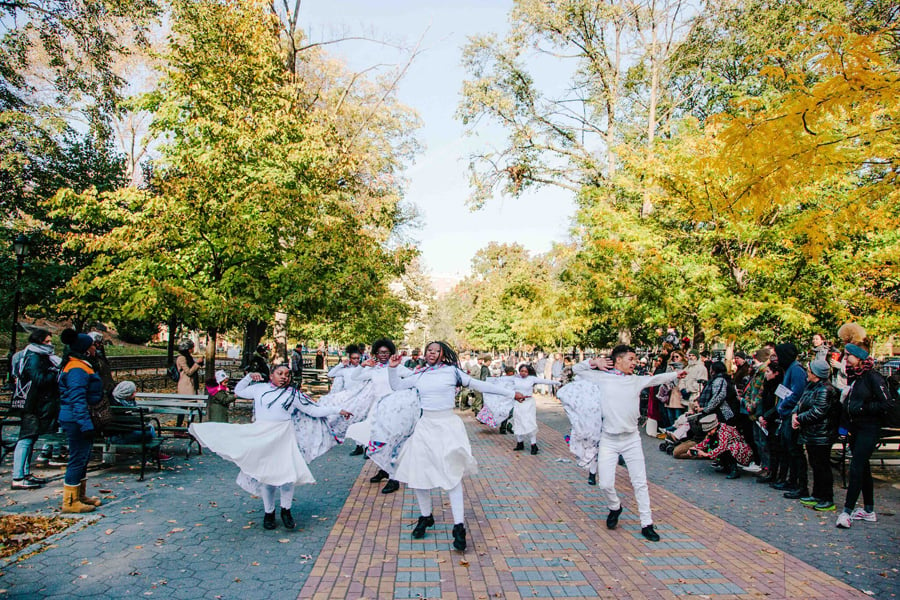
June 18, 2020
An Online Exhibition Connects the Dots Between Performance and Architecture
Six months after the release of the namesake book during the latest installment of the biennial, PERFORMA has launched Bodybuilding, which features thirty-five architecture studios who engage with performativity.

Is architecture a period or a comma? Are built forms hermetic bodies or catalysts for action? PERFORMA curator Charles Aubin and architect Carlos Mínguez Carrascor, published Bodybuilding: Architecture and Performance, during the most recent installment of the PERFORMA 19 biennial in New York City last November. Noticing a lack of a comprehensive, multigenerational survey on the subject, the duo’s interest in investigating the ways architects engage with performance goes as far back as a symposium they co-organized at the Performa 17 Hub in 2017. The book, which features essays by Mabel O. Wilson and Bryony Roberts, Lluís Alexandre Casanovas Blanco, and Victoria Bugge Øye, seeded the fundamental approaches now deeply rooted in the online exhibition: the impact of movement on systematic urbanization, the body’s relationship to buildings and monuments, and architecture’s role in action, be it physical or sociopolitical.

According to Aubin, the digital exhibition, which streams a total of 35 works on the biennial’s website, adds flesh to concepts and performances that a book could only illustrate in two dimensions. “The audience can watch the footage of Hans Hollein demonstrating how to utilize his inflatable Mobile Office after reading about it in the book,” Aubin tells Metropolis. Revisiting the subject has also allowed the duo the opportunity to expand their subjects and include studios from a broader geography. Cape Town’s Wolff Architects, for example, was put on their radar in the last six months with their performance, Pumflet Luxarama, which was a commemorative procession they organized in September 2018 for the bygone Luxurama Theater in the city’s historically charged Wynberg neighborhood.

While architecture and performance are two inherently intertwined disciplines, the curators primarily focused on how architecture studios consider and utilize performance as a pragmatic method. “Performance can be traced in a rendering, a maquette, or a finished building,” says Aubin—he notes that they are particularly interested in cases in which transience and ephemerality of performance encounter the tactility of architecture. PERFORMA’s own repertoire has been resourceful in search of public-facing interventions such as Mabel O. Wilson and Bryony Roberts’s 2017 commission with Storefront for Art and Architecture, Marching On. Staged at and around Harlem’s Marcus Garvey Park, the performance blends visual and theoretical cues from 1917’s anti-racist Silent March on Manhattan’s 5th Avenue, marching bands of historically black colleges, and hip-hop choreographies.
The 2017 biennial is also a source for Jimmy Robert’s Imitation of Lives, in which Philip Johnson’s Glass House provides a transparent dome for activist gestures, rendered in the subtlety of the Modernist aesthetic. With references to the cabaret singer Jimmie Daniels to David Hammons’s 1993 sculpture, In the Hood, the performance immerses the meandering audience and encourages the questioning of subjugation and entitlement within a space.

Chance determines the succession of the overall exhibition programming, à la cable network, which Aubin notes to prompt a habit of returning amongst the audience. On any given day until July 15, the hourly line-up features multigenerational globe-trotting attempts of performativity within or outside built environments, in relation to or against their physical dominances. Decolonizing Architecture Art Residency’s Al Madafeh (2016) documents what later turned into a series of house visit performances with Syrian and Palestinian refugees; Mile-Long Opera, 1,000-singer choral performances Diller Scofidio + Renfro spreads across The High Line for a sequence of six nights in 2018; or black and white documentation of Didier Fíuza Faustino’s piercingly operatic performance on subverting architectural and ritualistic codes of police brutality, titled Love Songs for Riots (2013).
Each of the thirty-five works in Bodybuilding embraces architecture as a backdrop, a blank canvas to color with activation and human inhibition, but they also problematize its frequently hospitable yet occasionally dismissive omnipresence over the body as a collective and individual entity.
You may also enjoy “With the Reissue of Reyner Banham’s Classic, Tracing the Megastructural Moment”
Would you like to comment on this article? Send your thoughts to: [email protected]
Register here for Metropolis Webinars
Connect with experts and design leaders on the most important conversations of the day.





















